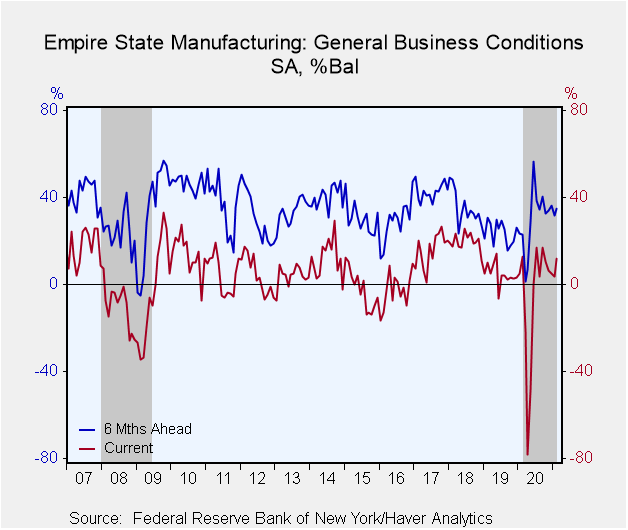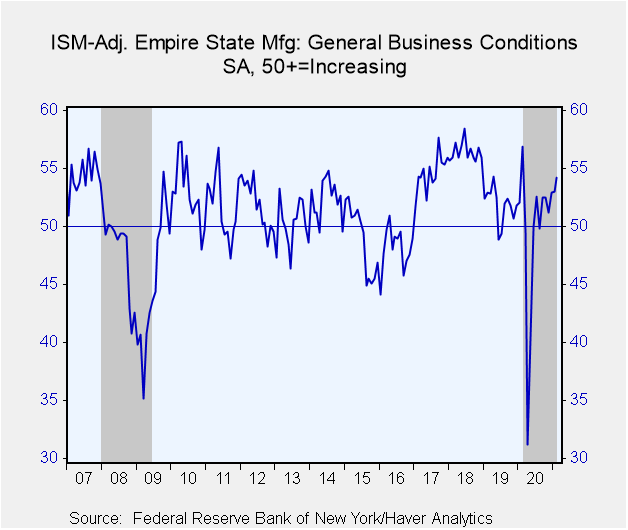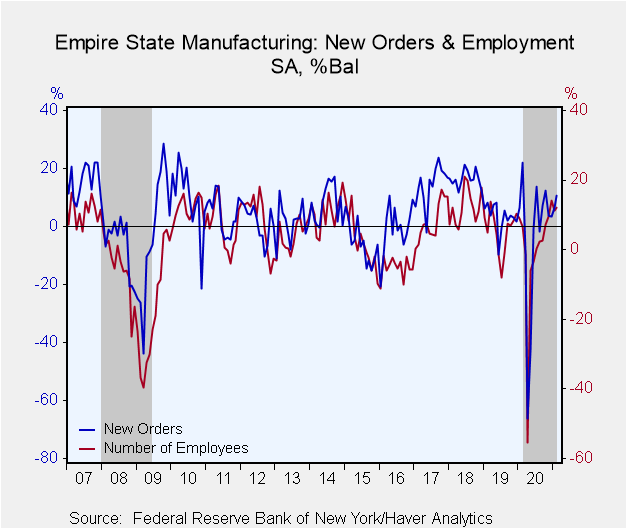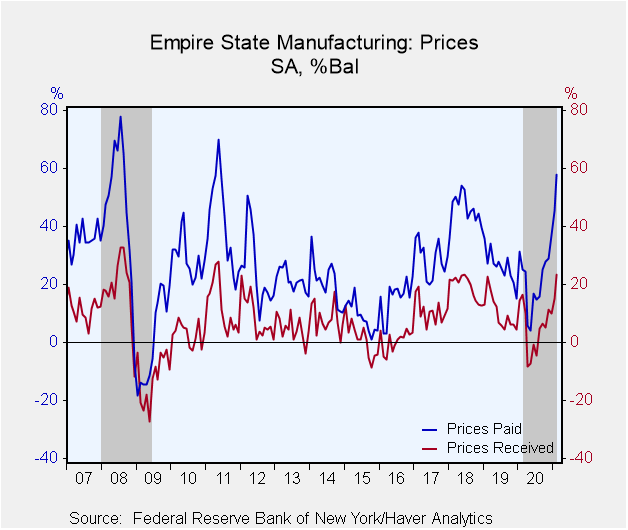 Global| Feb 16 2021
Global| Feb 16 2021Empire State Manufacturing Index Improves During February
by:Tom Moeller
|in:Economy in Brief
Summary
• Business conditions measure increases for first time in five months. • Component improvement is widespread. • Prices strengthen. The Empire State Manufacturing Index of General Business Conditions increased to 12.1 in February from [...]
• Business conditions measure increases for first time in five months.
• Component improvement is widespread.
• Prices strengthen.
The Empire State Manufacturing Index of General Business Conditions increased to 12.1 in February from 3.5 in January. A reading of 6.2 had been expected in the Informa Global Markets Survey. An improved 32% of respondents expected business conditions to increase while a lessened 20% expected deterioration. The Empire State data, reported by the Federal Reserve Bank of New York, reflect business conditions in the manufacturing sector in New York, northern New Jersey and southern Connecticut. The data was collected between February 2 and February 9. The headline measure is constructed from the answer to a single question on business conditions
Haver Analytics calculates a seasonally adjusted index that is comparable to the ISM series. The ISM-adjusted Empire State Index rose to 54.2 from 53.0. It was the highest level in twelve months, up from an April 2020 low of 31.2.
Movement amongst the Empire State components was mostly positive this month. The new orders measure rose to its highest level in four months as a greater 35% of respondents reported improvement. Unfilled orders rose sharply to the highest level in twelve months. The delivery times and inventory measures surged. To the downside was the shipments measure which retreated to the lowest level since last June. Twenty-nine percent of respondents reported an increase, compared to 37% twelve months earlier.
The employment index rose modestly to 12.1 from 11.2. A steady 20% of respondents reported increased hiring while a steady eight percent reported a decline. The average workweek index rose to the highest level since October.
The prices paid index strengthened to 57.8 from 45.5, its highest level since May 2011. A greatly increased 59% of respondents raised prices while only one percent reported lowering them. The prices received measure surged to 23.4, a sharp contrast with price deflation last spring.
The series measuring expectations for business conditions in six months rose to 34.9 but has been under pressure since the initial bounce-back in activity last summer.
The Empire State figures are diffusion indexes, which are calculated by subtracting the percent of respondents reporting declines from those reporting gains. The data are available in Haver's SURVEYS database. The ISM-adjusted headline index dates back to 2001. The Action Economics Forecasts can be found in Haver's AS1REPNA database.
| Empire State Manufacturing Survey | Feb | Jan | Dec | Feb'20 | 2020 | 2019 | 2018 |
|---|---|---|---|---|---|---|---|
| General Business Conditions (Diffusion Index, %, SA) | 12.1 | 3.5 | 4.9 | 12.9 | -5.9 | 4.8 | 19.7 |
| General Business Conditions Index (ISM Adjusted, >50=Increasing Activity, SA) | 54.2 | 53.0 | 52.9 | 56.9 | 49.3 | 51.8 | 56.4 |
| New Orders | 10.8 | 6.6 | 3.4 | 22.1 | -4.3 | 3.3 | 16.4 |
| Shipments | 4.0 | 7.3 | 12.1 | 18.9 | -0.2 | 10.5 | 20.3 |
| Unfilled Orders | 2.6 | -5.5 | -3.6 | 4.5 | -7.7 | -6.0 | 3.5 |
| Delivery Time | 9.1 | 5.5 | 4.3 | 8.3 | 2.7 | -0.1 | 9.1 |
| Inventories | 6.5 | -0.7 | -4.3 | 12.9 | -3.9 | -0.9 | 5.9 |
| Number of Employees | 12.1 | 11.2 | 14.2 | 6.6 | -1.2 | 5.4 | 12.3 |
| Average Employee Workweek | 9.0 | 6.3 | 4.8 | -1.0 | -6.9 | 2.3 | 7.8 |
| Prices Paid | 57.8 | 45.5 | 37.1 | 25.0 | 21.5 | 26.3 | 45.8 |
| Prices Received | 23.4 | 15.2 | 10.0 | 16.7 | 4.8 | 10.3 | 19.3 |
| Expectations 6 Months Ahead | 34.9 | 31.9 | 36.3 | 22.9 | 29.7 | 23.9 | 35.2 |
Tom Moeller
AuthorMore in Author Profile »Prior to joining Haver Analytics in 2000, Mr. Moeller worked as the Economist at Chancellor Capital Management from 1985 to 1999. There, he developed comprehensive economic forecasts and interpreted economic data for equity and fixed income portfolio managers. Also at Chancellor, Mr. Moeller worked as an equity analyst and was responsible for researching and rating companies in the economically sensitive automobile and housing industries for investment in Chancellor’s equity portfolio. Prior to joining Chancellor, Mr. Moeller was an Economist at Citibank from 1979 to 1984. He also analyzed pricing behavior in the metals industry for the Council on Wage and Price Stability in Washington, D.C. In 1999, Mr. Moeller received the award for most accurate forecast from the Forecasters' Club of New York. From 1990 to 1992 he was President of the New York Association for Business Economists. Mr. Moeller earned an M.B.A. in Finance from Fordham University, where he graduated in 1987. He holds a Bachelor of Arts in Economics from George Washington University.










